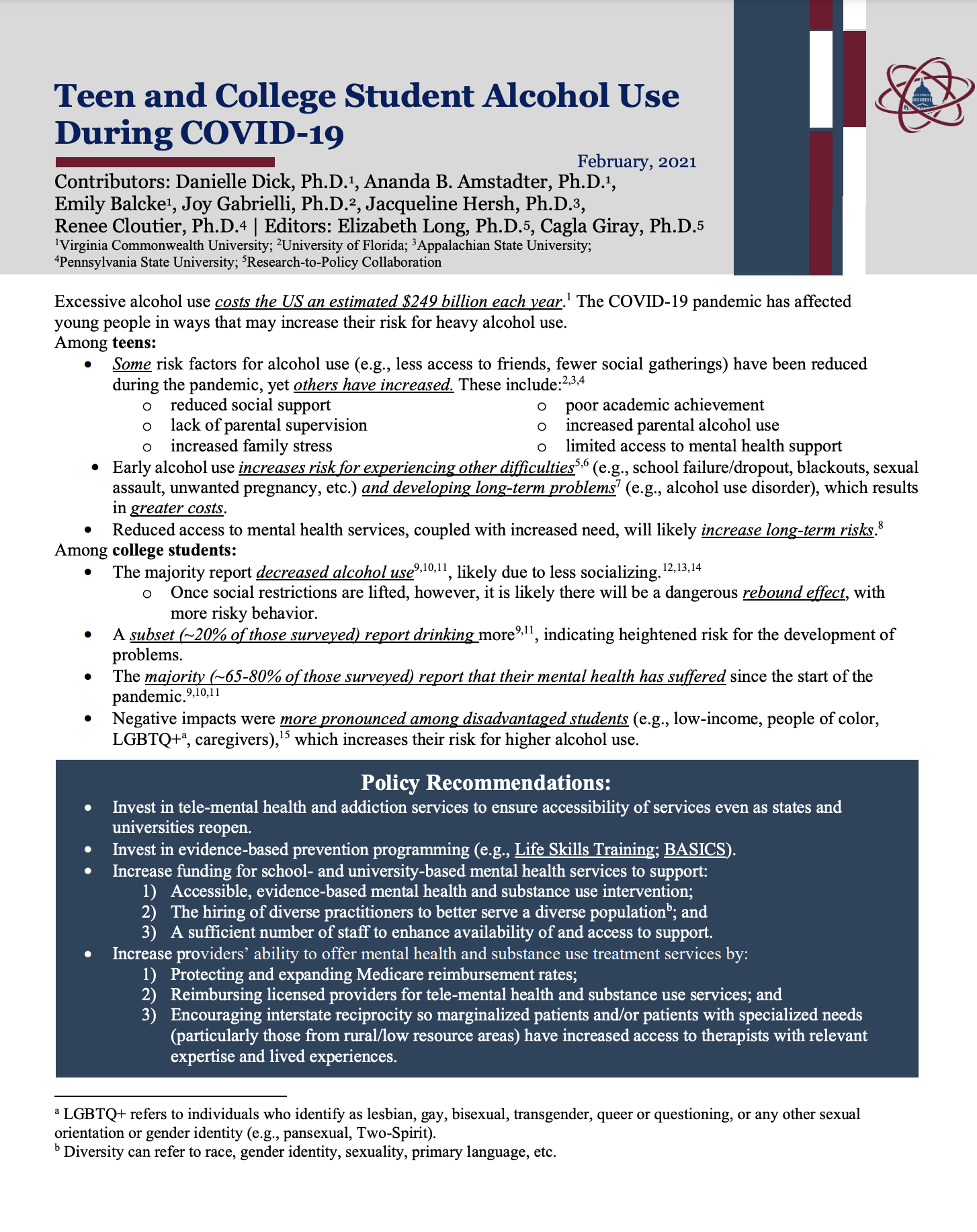
Excessive alcohol use costs the US an estimated $249 billion each year.[1] The COVID-19 pandemic has affected young people in ways that may increase their risk for heavy alcohol use.
Among Teens:
- Some risk factors for alcohol use (e.g., less access to friends, fewer social gatherings) have been reduced during the pandemic, yet others have increased. These include:[2],[3],[4]
- reduced social support
- lack of parental supervision
- increased family stress
- poor academic achievement
- increased parental alcohol use
- limited access to mental health support
- Early alcohol use increases risk for experiencing other difficulties[5],[6] (e.g., school failure/dropout, blackouts, sexual assault, unwanted pregnancy, etc.) and developing long-term problems[7] (e.g., alcohol use disorder), which results in greater costs.
- Reduced access to mental health services, coupled with increased need, will likely increase long-term risks.[8]
Among College Students:
- The majority report decreased alcohol use[9],[10],[11], likely due to less socializing.[12],[13],[14]
- Once social restrictions are lifted, however, it is likely there will be a dangerous rebound effect, with more risky behavior.
- A subset (~20% of those surveyed) report drinking more[9],[11], indicating heightened risk for the development of problems.
- The majority (~65-80% of those surveyed) report that their mental health has suffered since the start of the pandemic.[9],[10],[11]
- Negative impacts were more pronounced among disadvantaged students (e.g., low-income, people of color, LGBTQ+[a], caregivers),[15] which increases their risk for higher alcohol use.
Policy Recommendations
- Invest in tele-mental health and addiction services to ensure accessibility of services even as states and universities reopen.
- Invest in evidence-based prevention programming (e.g., Life Skills Training; BASICS).
- Increase funding for school- and university-based mental health services to support:
- Accessible, evidence-based mental health and substance use intervention;
- The hiring of diverse practitioners to better serve a diverse population[b]; and
- A sufficient number of staff to enhance availability of and access to support.
- Increase providers’ ability to offer mental health and substance use treatment services by:
- Protecting and expanding Medicare reimbursement rates;
- Reimbursing licensed providers for tele-mental health and substance use services; and
- Encouraging interstate reciprocity so marginalized patients and/or patients with specialized needs (particularly those from rural/low resource areas) have increased access to therapists with relevant expertise and lived experiences.
a. LGBTQ+ refers to individuals who identify as lesbian, gay, bisexual, transgender, queer or questioning, or any other sexual orientation or gender identity (e.g., pansexual, Two-Spirit).
b. Diversity can refer to race, gender identity, sexuality, primary language, etc.
End Notes / References
- Centers for Disease Control and Prevention. Excessive Drinking is Draining the U.S. Economy. https://www.cdc.gov/features/costsofdrinking/ Updated January 2016. Accessed April 21, 2017.
- Dumas, T. M., Ellis, W., & Litt, D. M. (2020). What does adolescent substance use look like during the COVID-19 pandemic? Examining changes in frequency, social contexts, and pandemic-related predictors. Journal of Adolescent Health, 67(3), 354-361.
- Cluver, L., Lachman, J. M., Sherr, L., Wessels, I., Krug, E., Rakotomalala, S., … & McDonald, K. (2020). Parenting in a time of COVID-19. Lancet, 395(10231).
- Zaccoletti, S., Camacho, A., Correia, N., Aguiar, C., Mason, L., Alves, R. A., & Daniel, J. R. (2020). Parents’ perceptions of student academic motivation during the COVID-19 lockdown: A cross-country comparison. Frontiers in Psychology, 11.
- Office of Juvenile Justice and Delinquency Prevention. Consequences of youth substance abuse. https://ojjdp.ojp.gov/sites/g/files/xyckuh176/files/pubs/drugid/ration-03.html
- National Research Council and Institute of Medicine (2004). Reducing underage drinking: A collective responsibility. Committee on Developing a Strategy to Reduce and Prevent Underage Drinking, Richard J. Bonnie and Mary Ellen O’Connell, Editors. Board on Children, Youth, and Families, Division of Behavioral and Social Sciences and Education. Washington, DC: The National Academies Press. https://www.ncbi.nlm.nih.gov/books/NBK37589/pdf/Bookshelf_NBK37589.pdf
- Grant, B. F., & Dawson, D. A. (1997). Age at onset of alcohol use and its association with DSM-IV alcohol abuse and dependence: Results from the national longitudinal alcohol epidemiologic survey. Journal of Substance Abuse, 9(1), 103–110. https://doi.org/10.1016/S0899-3289(97)90009-2
- Priester, M. A., Browne, T., Iachini, A., Clone, S., DeHart, D., & Seay, K. D. (2016). Treatment access barriers and disparities among individuals with co-occurring mental health and substance use disorders: an integrative literature review. Journal of substance abuse treatment, 61, 47-59.
- Course Hero & National Association of Student Personnel Administrators. (2020). Student wellness during COVID-19: What role do universities play in supporting their students? https://marketplace.collegepulse.com/img/student_wellness_collegepulse_final.pdf
- Healthy Minds Network (2020). The impact of COVID-19 on college student well-being. https://healthymindsnetwork.org/wp-content/uploads/2020/07/Healthy_Minds_NCHA_COVID_Survey_Report_FINAL.pdf
- Spit for Science, The VCU Student Survey Fall COVID-19 Survey. https://spit4science.vcu.edu/
- White, H. R., Stevens, A. K., Hayes, K., & Jackson, K. M. (2020). Changes in alcohol consumption among college students due to COVID-19: Effects of campus closure and residential change. Journal of Studies on Alcohol and Drugs, 81(6), 725-730.
- Beck, K. H., Caldeira, K. M., Vincent, K. B., & Arria, A. M. (2013). Social contexts of drinking and subsequent alcohol use disorder among college students. The American journal of drug and alcohol abuse, 39(1), 38-43.
- Cooper, M. L., Kuntsche, E., Levitt, A., Barber, L. L, & Wolf, S. (2016). Motivational models of substance use: A review of theory and research on motives for using alcohol, marijuana, and tobacco. In K. J. Sher (Ed.), Oxford library of psychology. The Oxford handbook of substance use and substance use disorders (p. 375–421). Oxford University Press.
- Chirikov, I., Soria, K. M, Horgos, B., & Jones-White, D. (2020). Undergraduate and graduate students’ mental health during the COVID-19 pandemic. UC Berkeley: Center for Studies in Higher Education. Retrieved from https://escholarship.org/uc/item/80k5d5hw
The Research-to-Policy Collaboration (RPC) works to bring together research professionals and public officials to support evidence-based policy. Please visit their website to learn more.
Key Information
RPC Website
Research-to-Policy Collaboration
Publication DateFebruary 1, 2021
Topic Area(s)Health, Substance Use and Misuse
Resource TypeWritten Briefs
Share This Page
Excessive alcohol use costs the US an estimated $249 billion each year.[1] The COVID-19 pandemic has affected young people in ways that may increase their risk for heavy alcohol use.
Among Teens:
- Some risk factors for alcohol use (e.g., less access to friends, fewer social gatherings) have been reduced during the pandemic, yet others have increased. These include:[2],[3],[4]
- reduced social support
- lack of parental supervision
- increased family stress
- poor academic achievement
- increased parental alcohol use
- limited access to mental health support
- Early alcohol use increases risk for experiencing other difficulties[5],[6] (e.g., school failure/dropout, blackouts, sexual assault, unwanted pregnancy, etc.) and developing long-term problems[7] (e.g., alcohol use disorder), which results in greater costs.
- Reduced access to mental health services, coupled with increased need, will likely increase long-term risks.[8]
Among College Students:
- The majority report decreased alcohol use[9],[10],[11], likely due to less socializing.[12],[13],[14]
- Once social restrictions are lifted, however, it is likely there will be a dangerous rebound effect, with more risky behavior.
- A subset (~20% of those surveyed) report drinking more[9],[11], indicating heightened risk for the development of problems.
- The majority (~65-80% of those surveyed) report that their mental health has suffered since the start of the pandemic.[9],[10],[11]
- Negative impacts were more pronounced among disadvantaged students (e.g., low-income, people of color, LGBTQ+[a], caregivers),[15] which increases their risk for higher alcohol use.
Policy Recommendations
- Invest in tele-mental health and addiction services to ensure accessibility of services even as states and universities reopen.
- Invest in evidence-based prevention programming (e.g., Life Skills Training; BASICS).
- Increase funding for school- and university-based mental health services to support:
- Accessible, evidence-based mental health and substance use intervention;
- The hiring of diverse practitioners to better serve a diverse population[b]; and
- A sufficient number of staff to enhance availability of and access to support.
- Increase providers’ ability to offer mental health and substance use treatment services by:
- Protecting and expanding Medicare reimbursement rates;
- Reimbursing licensed providers for tele-mental health and substance use services; and
- Encouraging interstate reciprocity so marginalized patients and/or patients with specialized needs (particularly those from rural/low resource areas) have increased access to therapists with relevant expertise and lived experiences.
a. LGBTQ+ refers to individuals who identify as lesbian, gay, bisexual, transgender, queer or questioning, or any other sexual orientation or gender identity (e.g., pansexual, Two-Spirit).
b. Diversity can refer to race, gender identity, sexuality, primary language, etc.
End Notes / References
- Centers for Disease Control and Prevention. Excessive Drinking is Draining the U.S. Economy. https://www.cdc.gov/features/costsofdrinking/ Updated January 2016. Accessed April 21, 2017.
- Dumas, T. M., Ellis, W., & Litt, D. M. (2020). What does adolescent substance use look like during the COVID-19 pandemic? Examining changes in frequency, social contexts, and pandemic-related predictors. Journal of Adolescent Health, 67(3), 354-361.
- Cluver, L., Lachman, J. M., Sherr, L., Wessels, I., Krug, E., Rakotomalala, S., … & McDonald, K. (2020). Parenting in a time of COVID-19. Lancet, 395(10231).
- Zaccoletti, S., Camacho, A., Correia, N., Aguiar, C., Mason, L., Alves, R. A., & Daniel, J. R. (2020). Parents’ perceptions of student academic motivation during the COVID-19 lockdown: A cross-country comparison. Frontiers in Psychology, 11.
- Office of Juvenile Justice and Delinquency Prevention. Consequences of youth substance abuse. https://ojjdp.ojp.gov/sites/g/files/xyckuh176/files/pubs/drugid/ration-03.html
- National Research Council and Institute of Medicine (2004). Reducing underage drinking: A collective responsibility. Committee on Developing a Strategy to Reduce and Prevent Underage Drinking, Richard J. Bonnie and Mary Ellen O’Connell, Editors. Board on Children, Youth, and Families, Division of Behavioral and Social Sciences and Education. Washington, DC: The National Academies Press. https://www.ncbi.nlm.nih.gov/books/NBK37589/pdf/Bookshelf_NBK37589.pdf
- Grant, B. F., & Dawson, D. A. (1997). Age at onset of alcohol use and its association with DSM-IV alcohol abuse and dependence: Results from the national longitudinal alcohol epidemiologic survey. Journal of Substance Abuse, 9(1), 103–110. https://doi.org/10.1016/S0899-3289(97)90009-2
- Priester, M. A., Browne, T., Iachini, A., Clone, S., DeHart, D., & Seay, K. D. (2016). Treatment access barriers and disparities among individuals with co-occurring mental health and substance use disorders: an integrative literature review. Journal of substance abuse treatment, 61, 47-59.
- Course Hero & National Association of Student Personnel Administrators. (2020). Student wellness during COVID-19: What role do universities play in supporting their students? https://marketplace.collegepulse.com/img/student_wellness_collegepulse_final.pdf
- Healthy Minds Network (2020). The impact of COVID-19 on college student well-being. https://healthymindsnetwork.org/wp-content/uploads/2020/07/Healthy_Minds_NCHA_COVID_Survey_Report_FINAL.pdf
- Spit for Science, The VCU Student Survey Fall COVID-19 Survey. https://spit4science.vcu.edu/
- White, H. R., Stevens, A. K., Hayes, K., & Jackson, K. M. (2020). Changes in alcohol consumption among college students due to COVID-19: Effects of campus closure and residential change. Journal of Studies on Alcohol and Drugs, 81(6), 725-730.
- Beck, K. H., Caldeira, K. M., Vincent, K. B., & Arria, A. M. (2013). Social contexts of drinking and subsequent alcohol use disorder among college students. The American journal of drug and alcohol abuse, 39(1), 38-43.
- Cooper, M. L., Kuntsche, E., Levitt, A., Barber, L. L, & Wolf, S. (2016). Motivational models of substance use: A review of theory and research on motives for using alcohol, marijuana, and tobacco. In K. J. Sher (Ed.), Oxford library of psychology. The Oxford handbook of substance use and substance use disorders (p. 375–421). Oxford University Press.
- Chirikov, I., Soria, K. M, Horgos, B., & Jones-White, D. (2020). Undergraduate and graduate students’ mental health during the COVID-19 pandemic. UC Berkeley: Center for Studies in Higher Education. Retrieved from https://escholarship.org/uc/item/80k5d5hw
The Research-to-Policy Collaboration (RPC) works to bring together research professionals and public officials to support evidence-based policy. Please visit their website to learn more.

Key Information
RPC Website
Research-to-Policy Collaboration
Publication DateFebruary 1, 2021
Topic Area(s)Health, Substance Use and Misuse
Resource TypeWritten Briefs
Share This Page
LET’S STAY IN TOUCH
Join the Evidence-to-Impact Mailing List
Keep up to date with the latest resources, events, and news from the EIC.




